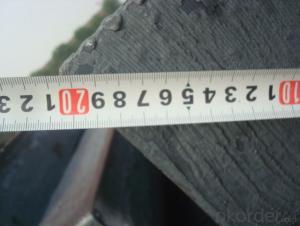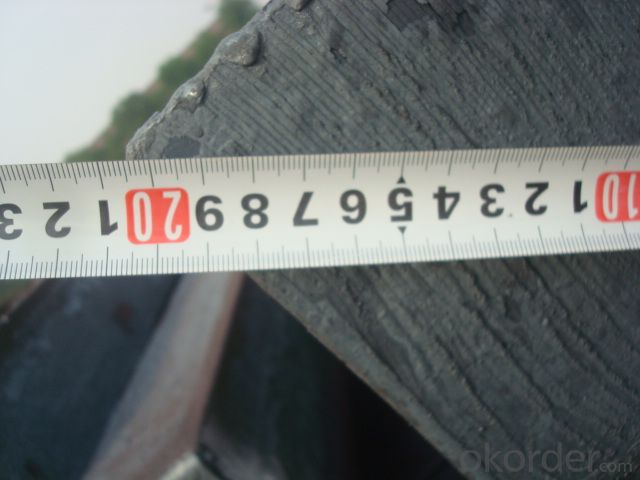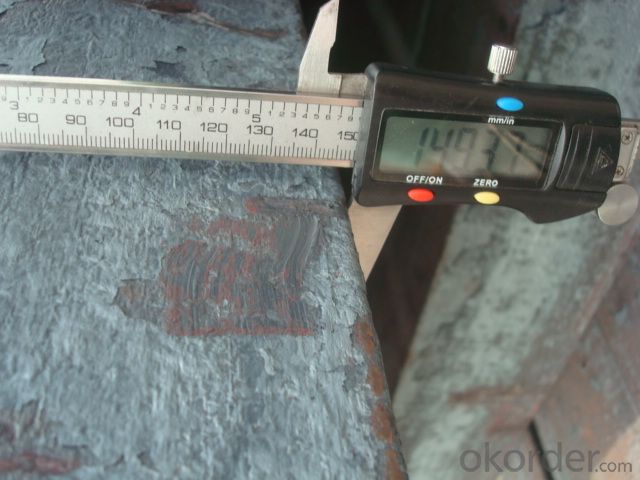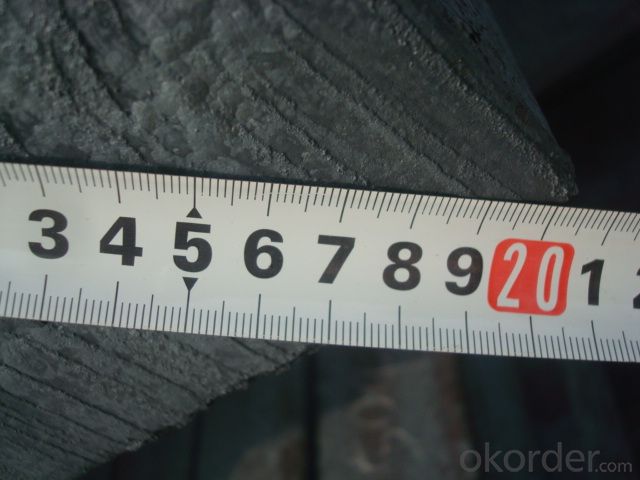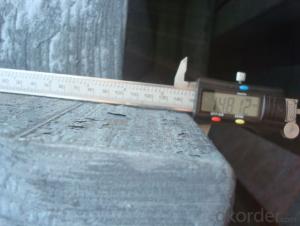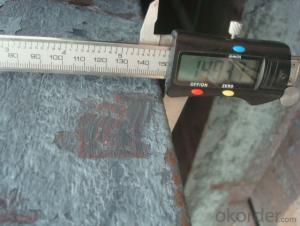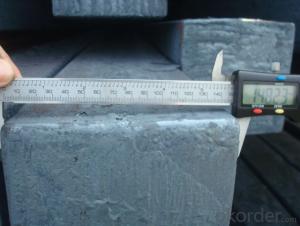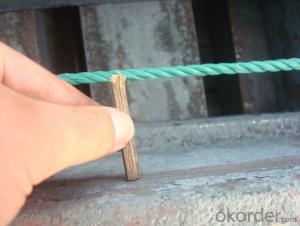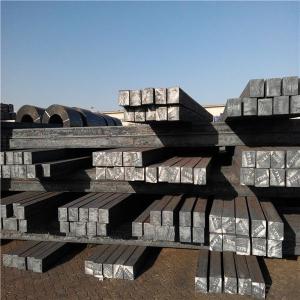Steel Billet Hot Rolled in Amazing Prices
- Loading Port:
- Tianjin
- Payment Terms:
- TT OR LC
- Min Order Qty:
- 1000 m.t.
- Supply Capability:
- 50000 m.t./month
OKorder Service Pledge
OKorder Financial Service
You Might Also Like
1.Structure of Steel Billet
Steel billet(ingot) by cogging or breakdown of semi-finished products, is the raw material of all kinds of steel mill. Billet section of square, round, flat, rectangular and abnormity of several kinds of, mainly related to the shape of rolled products.
2.Main Features of Steel Billet
Rectangular billet continuous casting billet and mainly general carbon steel, low carbon low silicon cold-rolled material, high quality carbon structural steel, high strength low alloy steel, special steel, etc.
The billet is mainly divided into two kinds from the shape:
Slab: cross section width and height of the ratio of the larger, mainly used for rolling plate.
Billet: equal cross section width and height, or a huge difference, mainly used for rolling steel, wire rod. ,
Steel billets have distinct characteristics as compared with already furnished steel bars and products. Billets have a specific grain structure, which enables the metal to be processed more intricately. Steel billets are also known for their malleability and ductility, especially when exposed to varying temperatures during shaping and molding.
3.Processing of Steel Billet
Steel billets are considered fresh and raw, and they must undergo a series of manufacturing processes before they can be used for various purposes. Billets are made by means of freezing molten liquid, and are later exposed to extremely low temperatures in order to allow the metal to take shape and solidify in chemical structure. The temperature manipulates the metal's physical properties, and tones its strength and durability. The subsequent processes provide the metal's curved mold design so that it can fit the allotted space provided by other machines, which complete the finishing procedures.
4.Steel Billet Images
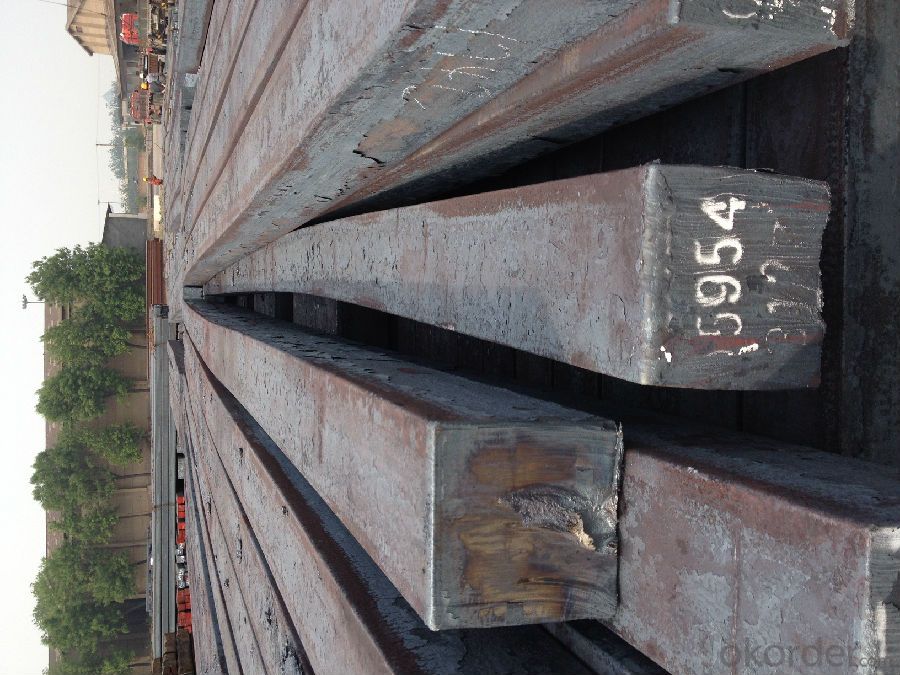
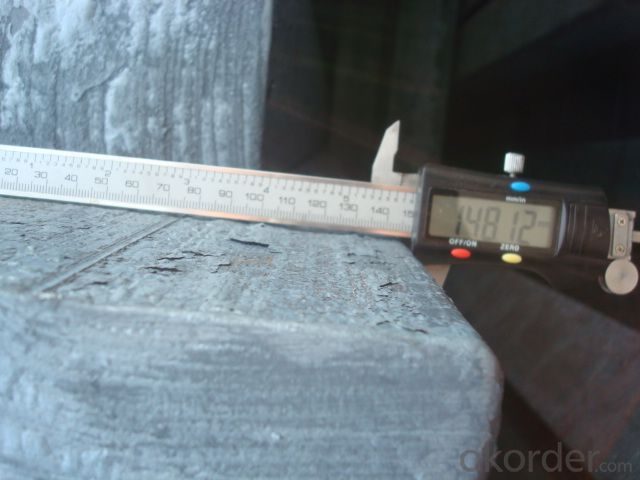
5. Steel Billet Specification
Hot rolled billet steel
Size: 50x50mm-180x180mm
Steel Grade: 3SP, 5SP,Q195,Q235,Q255,Q275 Length:3m-12m
MOQ: 1000MT/size
Payment term: TT or LC
Packing: in bulk , bundle
Shipment: by container , bulk vessel
Packaging Details: bundles with steel strips or as customers's requirements
Delivery time: 15-30 days after the deposit
Loading port:Tianjin, or other port China
Origin :China
Inspection:Third party inspection before loading.
6.FAQ
We have organized several common questions for our clients,may help you sincerely:
1) How to guarantee the quality of the products?
We have established the international advanced quality management system,every link from raw material to final product we have strict quality test;We resolutely put an end to unqualified products flowing into the market. At the same time, we will provide necessary follow-up service assurance.
2) How long can we receive the product after purchase?
In the purchase of product within three working days, We will arrange the factory delivery as soon as possible. The pecific time of receiving is related to the state and position of customers.Commonly 7 to 10 working days can be served.
I want to order some goods with small qty. but more varieties, can you accept the order?
A: Would you pls send the qty. of each model to us by email? We will check it and reply you soon.
- Q: How are steel billets used in the manufacturing of power generation equipment?
- Steel billets are used in the manufacturing of power generation equipment as they serve as the starting material for various components such as turbine blades, rotors, casings, and shafts. These billets are shaped, machined, and heat-treated to meet the specific requirements of the equipment, ensuring high strength, durability, and resistance to extreme operating conditions.
- Q: What are the main factors affecting the machined surface quality of steel billets?
- There are several main factors that significantly affect the machined surface quality of steel billets. These factors include: 1. Cutting Speed: The cutting speed, which is the speed at which the tool moves across the surface of the billet, plays a crucial role in determining the surface quality. Higher cutting speeds can lead to increased heat generation, which can cause thermal damage to the surface and result in poor quality. Therefore, finding the optimal cutting speed is essential for achieving a high-quality machined surface. 2. Feed Rate: The feed rate refers to the rate at which the tool advances into the material during the machining process. A high feed rate can lead to excessive tool wear, resulting in poor surface quality. On the other hand, a low feed rate may cause chatter or vibration, causing surface irregularities. It is crucial to find the right balance to ensure a smooth and high-quality machined surface. 3. Tool Geometry: The geometry of the cutting tool, including its shape, angle, and edge sharpness, plays a significant role in determining the surface quality. The tool geometry affects the chip formation and the interaction between the tool and the billet. Proper tool geometry can minimize cutting forces, reduce vibration, and improve chip evacuation, resulting in a better surface finish. 4. Cutting Fluid: The choice and application of cutting fluids can greatly influence the surface quality of machined steel billets. Cutting fluids serve multiple purposes, including cooling the tool and workpiece, lubricating the cutting process, and flushing away chips. Appropriate cutting fluid selection and application can help in reducing friction, heat generation, and tool wear, leading to improved surface quality. 5. Billet Material and Hardness: The material composition and hardness of the steel billet also impact the machined surface quality. Different steels have varying levels of machinability, with some being more prone to issues like work hardening or built-up edge formation. Harder materials generally require more robust cutting tools and specific machining techniques to achieve desired surface quality. 6. Machine Rigidity and Stability: The rigidity and stability of the machine used for machining the steel billets are critical factors affecting the surface quality. Any machine tool deflection or vibration can lead to poor surface finish and dimensional accuracy. Therefore, it is essential to ensure proper machine setup, alignment, and maintenance to minimize unwanted vibrations and maximize surface quality. Overall, a combination of the above factors, along with proper cutting parameters and machining techniques, is necessary to achieve a high-quality machined surface on steel billets. Adjusting these factors based on the specific characteristics of the billet and desired surface finish can help optimize the machining process and improve the overall quality of the final product.
- Q: What are the different methods of steel billet surface inspection?
- In the industry, various methods are commonly employed for inspecting the surface of steel billets. These techniques aim to identify any flaws or imperfections, guaranteeing the use of high-quality steel in the manufacturing process. 1. Visual inspection: Trained inspectors visually examine the billet's surface for visible defects like cracks, dents, scratches, or irregularities. While a straightforward approach, it serves as a crucial initial step in the inspection process. 2. Magnetic particle inspection: This method involves applying a magnetic field to the billet's surface and then introducing iron particles suspended in liquid. If there are any surface defects or cracks, the iron particles adhere to them, creating a visible indication. This technique is especially effective for detecting surface cracks. 3. Eddy current testing: Employing electromagnetic induction, this method detects surface defects. A probe is passed over the billet's surface, and any changes in electrical conductivity caused by cracks or defects generate eddy currents, which can be identified and analyzed. It is commonly used for detecting surface cracks, but it can also measure coating thickness or identify material property variations. 4. Ultrasonic testing: Ultrasonic waves are utilized to inspect the billet's surface for defects. A transducer sends ultrasonic waves into the material, and any changes in the wave pattern caused by surface defects are detected and analyzed. This method is frequently employed for detecting surface cracks, but it also provides insight into the internal structure of the billet. 5. Dye penetrant inspection: This method involves applying colored dye to the billet's surface, which is then removed, leaving the dye trapped within any defects or cracks. A developer is then applied to enhance the visibility of the dye, facilitating the identification and localization of surface defects. It is particularly effective for detecting small surface cracks. 6. Laser scanning: Laser scanning employs a laser beam to scan the billet's surface and generate a three-dimensional representation. This method is valuable for detecting surface irregularities, measuring dimensions, and creating digital models for further analysis. Each of these methods possesses unique advantages and limitations, often employed in combination to ensure a comprehensive inspection of the steel billet's surface. The choice of inspection method depends on factors such as the targeted defects, billet size and shape, and desired level of accuracy.
- Q: How are steel billets used in the manufacturing of construction formwork?
- Steel billets are used in the manufacturing of construction formwork as they are often shaped and molded into various components, such as beams or columns, that provide essential structural support. These billets are strong and durable, ensuring the formwork can withstand the weight and pressure of poured concrete. Additionally, their malleability allows for customization, enabling the formwork to be precisely designed to meet the specific requirements of each construction project.
- Q: Can steel billets be used in the production of automotive components?
- Yes, steel billets can be used in the production of automotive components. Steel billets are semi-finished steel products that are typically used to produce various types of steel products, including automotive components. They can be further processed through rolling, forging, or other manipulation techniques to form the desired shape and size of the automotive component. Steel is a preferred material for automotive components due to its high strength, durability, and ability to withstand harsh operating conditions. Moreover, the use of steel billets allows for flexibility in manufacturing, as they can be tailored to meet specific design requirements and performance specifications of different automotive components.
- Q: How are steel billets used in the production of mining machinery?
- Steel billets are used in the production of mining machinery as they serve as the raw material for forging and shaping various components such as gears, shafts, frames, and structural elements. These billets are heated and then formed into desired shapes through processes like rolling, machining, and welding. The high strength and durability of steel make it ideal for withstanding the harsh conditions and heavy loads associated with mining operations, ensuring the reliability and performance of mining machinery.
- Q: What are the main factors affecting the corrosion resistance of alloy steel billets?
- The corrosion resistance of alloy steel billets is influenced by several key factors. Firstly, the composition of the alloy steel plays a crucial role in determining its resistance to corrosion. Alloy steels containing a higher percentage of elements such as chromium, nickel, and molybdenum tend to have enhanced corrosion resistance compared to steels with lower alloy content. Secondly, the presence of protective surface coatings or finishes can significantly improve the corrosion resistance of alloy steel billets. Various coatings, such as zinc or epoxy, act as a barrier between the metal surface and the corrosive environment, preventing the steel from coming into direct contact with corrosive agents. Additionally, the manufacturing process used to produce alloy steel billets can impact their corrosion resistance. Proper heat treatment and quenching processes can enhance the microstructure of the alloy, creating a more corrosion-resistant material. The environment in which the alloy steel billets are exposed is another crucial factor. Factors such as temperature, humidity, pH levels, and the presence of corrosive substances can all influence the corrosion resistance of the alloy steel billets. For example, exposure to high temperatures or acidic environments can accelerate corrosion, while exposure to dry or neutral conditions may have a minimal impact on corrosion resistance. Lastly, the design and maintenance of structures or equipment made from alloy steel billets can affect their corrosion resistance. Proper design considerations, such as avoiding sharp corners or crevices where moisture can accumulate, can help minimize the risk of corrosion. Regular inspection, cleaning, and maintenance can also help prevent corrosion by identifying and addressing any issues promptly. In conclusion, the main factors affecting the corrosion resistance of alloy steel billets include the composition of the steel, the presence of protective coatings, the manufacturing process, the environmental conditions, and the design and maintenance practices. By considering these factors, manufacturers and users can ensure that alloy steel billets exhibit optimal corrosion resistance in various applications.
- Q: What are the main factors affecting the hardness of steel billets?
- The hardness of steel billets is primarily determined by various factors. Firstly, the carbon content plays a vital role in determining steel hardness. Higher carbon content leads to increased hardness as carbon atoms occupy spaces between iron crystals, forming stronger bonds and enhancing material resistance to deformation. Secondly, the inclusion of alloying elements significantly affects steel hardness. Elements like chromium, molybdenum, and vanadium create solid solutions with iron, altering its crystal structure and strengthening the material. These elements facilitate the formation of fine and uniform microstructures, resulting in higher hardness. The heat treatment process is another crucial factor that impacts steel billet hardness. Controlled heating and rapid cooling, such as quenching and tempering, cause a transformation in the crystal structure of steel. This transformation, known as martensitic transformation, increases hardness by generating a high concentration of dislocations and reducing grain size. Furthermore, the cooling rate during solidification also affects steel billet hardness. Rapid cooling, like water quenching, promotes the formation of a fine microstructure and enhances hardness. Conversely, slower cooling rates allow for the growth of larger grains, leading to reduced hardness. Lastly, the presence of impurities and non-metallic inclusions can adversely affect steel billet hardness. These impurities disrupt the crystal lattice, reducing material strength and hardness. Therefore, the purity and cleanliness of the steel composition are crucial for achieving higher hardness levels. In conclusion, several factors, including carbon content, alloying elements, heat treatment processes, cooling rate, and the presence of impurities, influence the hardness of steel billets. To attain the desired hardness properties, it is essential to comprehend and control these factors.
- Q: Can steel billets be used in the production of electrical appliances?
- Yes, steel billets can be used in the production of electrical appliances. Steel billets are semi-finished products that are typically used to produce various steel products, including electrical appliances. The steel billets can be further processed and shaped into different components required for electrical appliances, such as casings, frames, brackets, and other structural parts. The use of steel provides strength, durability, and corrosion resistance, making it suitable for the demanding requirements of electrical appliances. Additionally, steel is a widely available and cost-effective material, making it a preferred choice for manufacturing electrical appliances.
- Q: What are the main factors affecting the creep resistance of steel billets?
- The main factors affecting the creep resistance of steel billets are temperature, stress level, and alloy composition. Temperature plays a crucial role in determining the creep resistance of steel billets. As the temperature increases, the atomic diffusion within the material becomes more active, leading to enhanced creep deformation. Higher temperatures allow for more rapid grain growth and can result in the formation of voids and cracks, ultimately weakening the billet's resistance to creep. The stress level applied to the steel billet also significantly affects its creep resistance. Higher stresses increase the rate of creep, as they promote dislocation movement within the crystal lattice. Additionally, stress concentration at various defects, such as voids or impurities, can accelerate creep deformation. Therefore, controlling the stress level is essential in maintaining the creep resistance of steel billets. The alloy composition of the steel billet is another critical factor influencing its creep resistance. Different alloying elements can alter the microstructure of the material, affecting its creep properties. For example, elements like chromium, molybdenum, and vanadium can form stable carbides that hinder dislocation movement and improve creep resistance. Other elements, such as sulfur or phosphorus, can promote grain boundary sliding and reduce creep resistance. In summary, the creep resistance of steel billets is primarily influenced by temperature, stress level, and alloy composition. By carefully controlling these factors, manufacturers can produce steel billets with enhanced creep resistance, ensuring their suitability for various applications.
Send your message to us
Steel Billet Hot Rolled in Amazing Prices
- Loading Port:
- Tianjin
- Payment Terms:
- TT OR LC
- Min Order Qty:
- 1000 m.t.
- Supply Capability:
- 50000 m.t./month
OKorder Service Pledge
OKorder Financial Service
Similar products
Hot products
Hot Searches
Related keywords
